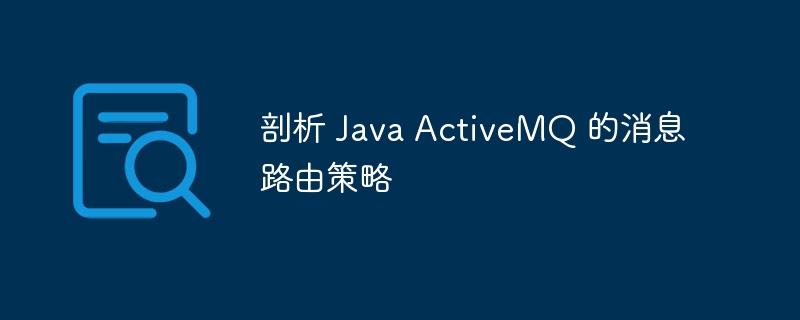Analyzing the message routing strategy of Java ActiveMQ
Feb 19, 2024 pm 06:36 PM
1. Simple routing
php editor Baicao will give you an in-depth analysis of the message routing strategy of Java ActiveMQ. Message routing is a crucial part of the message middleware system and directly affects the performance and reliability of the system. In ActiveMQ, how is the message routing strategy designed and implemented? What are the characteristics and applicable scenarios of different routing strategies? Through the analysis of this article, let us have an in-depth understanding of the mysteries of Java ActiveMQ message routing strategy.
<route> <from uri="queue:inbox"/> <to uri="queue:outbox"/> </route>
The above configuration will route all messages sent to the inbox queue to the outbox queue.
2. Destination routing
Destination routing policies allow messages to be routed to multiple destinations. The configuration of this policy is more complicated than a simple routing policy and requires specifying the names of multiple destinations.
<route> <from uri="queue:inbox"/> <to uri="queue:outbox1"/> <to uri="queue:outbox2"/> </route>
The above configuration will route all messages sent to the inbox queue to both the outbox1 and outbox2 queues.
3. Filter routing
Filter routing policy allows routing based on the attributes of the message. Configuration of this policy requires specifying a filter that is used to determine which messages should be routed to the target destination.
<route> <from uri="queue:inbox"/> <filter> <simple>header.priority == "high"</simple> </filter> <to uri="queue:outbox"/> </route>
The above configuration will route all messages with priority high to the outbox queue, while other messages will be discarded.
4. Load BalancingRouting
Load balancing routing policy allows messages to be routed evenly to multiple destinations. The configuration of this policy requires specifying the names of multiple destinations and the load balancing algorithm.
<route> <from uri="queue:inbox"/> <loadBalance> <roundRobin/> </loadBalance> <to uri="queue:outbox1"/> <to uri="queue:outbox2"/> </route>
The above configuration will route all messages sent to the inbox queue evenly to the outbox1 and outbox2 queues.
5. Summary
ActiveMQ Provides a variety of message routing strategies to meet the needs of different scenarios. This article analyzes the implementation principles of these routing strategies in detail, and shows how to use these routing strategies through demonstration code. I hope this article can help readers better understand and use ActiveMQ.
The above is the detailed content of Analyzing the message routing strategy of Java ActiveMQ. For more information, please follow other related articles on the PHP Chinese website!

Hot Article

Hot tools Tags

Hot Article

Hot Article Tags

Notepad++7.3.1
Easy-to-use and free code editor

SublimeText3 Chinese version
Chinese version, very easy to use

Zend Studio 13.0.1
Powerful PHP integrated development environment

Dreamweaver CS6
Visual web development tools

SublimeText3 Mac version
God-level code editing software (SublimeText3)

Hot Topics
 Java development: How to use Apache Camel for message routing and transformation
Sep 21, 2023 pm 04:24 PM
Java development: How to use Apache Camel for message routing and transformation
Sep 21, 2023 pm 04:24 PM
Java development: How to use Apache Camel for message routing and transformation
 Java ActiveMQ: Easily implement asynchronous communication in distributed systems
Feb 19, 2024 pm 10:18 PM
Java ActiveMQ: Easily implement asynchronous communication in distributed systems
Feb 19, 2024 pm 10:18 PM
Java ActiveMQ: Easily implement asynchronous communication in distributed systems
 PHP and Apache Camel integrated to implement message routing and exchange
Jun 25, 2023 am 09:37 AM
PHP and Apache Camel integrated to implement message routing and exchange
Jun 25, 2023 am 09:37 AM
PHP and Apache Camel integrated to implement message routing and exchange
 How to integrate ActiveMQ in SpringBoot
May 11, 2023 pm 06:16 PM
How to integrate ActiveMQ in SpringBoot
May 11, 2023 pm 06:16 PM
How to integrate ActiveMQ in SpringBoot
 Getting Started with Java JMS: Master the Basics of Messaging Technology Easily
Feb 26, 2024 am 10:34 AM
Getting Started with Java JMS: Master the Basics of Messaging Technology Easily
Feb 26, 2024 am 10:34 AM
Getting Started with Java JMS: Master the Basics of Messaging Technology Easily
 How to integrate Activemq in Springboot
May 21, 2023 pm 01:13 PM
How to integrate Activemq in Springboot
May 21, 2023 pm 01:13 PM
How to integrate Activemq in Springboot









